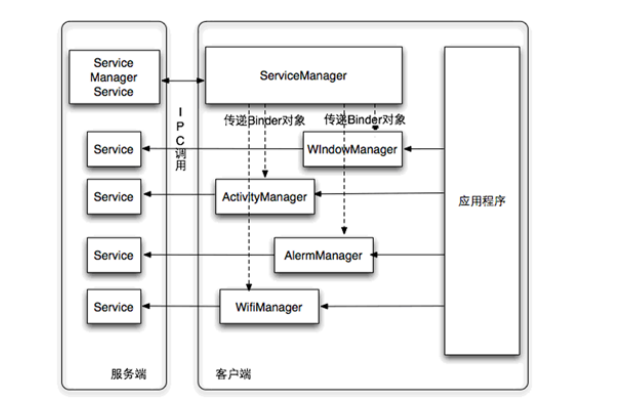10.1 Binder与SystemService
在我们编写APP程序的时候, 经常会是用getSystemService( String serviceName ) 这个方法,来获取一个系统的服务对象。我们查看源码:
frameworks/base/core/java/android/app下ContextImpl.java ,可以看到SystemService可以通过在WallpaperManager中获得到的,而WallpaperManager的initGlobals的构造函数中,则是用ServiceManager.getService( Context.WALLPAPAER_SERVICE) 获取到一个binder的对象。而看其他的源码,比如InputMethodManager他是通过单例模式获取的,如下:
registerService(INPUT_METHOD_SERVICE, new ServiceFetcher() {
public Object createService(ContextImpl ctx) {
return InputMethodManager.getInstance(ctx);
}});
而在InputMethodManager.java的getInstance方法中,我们可以看到如下:
/**
* Internally, the input method manager can't be context-dependent, so
* we have this here for the places that need it.
* @hide
*/
static public InputMethodManager getInstance(Looper mainLooper) {
synchronized (mInstanceSync) {
if (mInstance != null) {
return mInstance;
}
IBinder b = ServiceManager.getService(Context.INPUT_METHOD_SERVICE);
IInputMethodManager service = IInputMethodManager.Stub.asInterface(b);
mInstance = new InputMethodManager(service, mainLooper);
}
return mInstance;
}
可以看到,获取一个InputMethodManager对象,要先通过ServiceManager获取一个InputMethod Service的Binder对象b,然后在把这个Binder对象作为IInputManager.Stub.asInterface()的参数,返回一个InputMethodManager的统一接口,ServiceManager(android.os包下)的getService代码如下:
/**
* Returns a reference to a service with the given name.
*
* @param name the name of the service to get
* @return a reference to the service, or <code>null</code> if the service doesn't exist
*/
public static IBinder getService(String name) {
try {
IBinder service = sCache.get(name);
if (service != null) {
return service;
} else {
return getIServiceManager().getService(name);
}
} catch (RemoteException e) {
Log.e(TAG, "error in getService", e);
}
return null;
}
所以说,上面所做的就是先看我们需要的SystemService有没有在缓存中,没有的话,就获取到ServiceManager再获取。
其中getIServiceManager的代码如下:
private static IServiceManager getIServiceManager() {
if (sServiceManager != null) {
return sServiceManager;
}
// Find the service manager
sServiceManager = ServiceManagerNative.asInterface(BinderInternal.getContextObject());
return sServiceManager;
}
上面的BinderInternal.getContextObject()方法,返回的是ServiceManager的全局服务代理对象,也就是一个BpBinder对象,方法是原生的方法,具体可以查看android_util_binder.cpp文件。服务会在Framework启动的时候,创建并且添加的。这个在这边就先不详细介绍了。
10.2 详述Manager
Manager管理的就是服务,并且一个Manager往往管理一个服务,而且Manager更多的时候,调用服务本身的API接口,由于服务都是其他进程,因此,Manager内部使用的是Binder来实现远程调用,Manager隐藏了服务的实现细节,所以客户端并不直接通过调用Binder来访问这些服务,而是调用Manager的方法,所以,我们可以说,Manager将服务的操作、实现细节都封装了起来。这样Manager就相当于客户端通往SystemService的中间件,并使得我们可以灵活、可控地定制API。
比如说AMS,我们一般不希望用户直接访问AMS,而是通过ActivityManager来访问,而ActivityManager内部提供了一些更具有操作性的数据结构,比如RecentTaskInfo数据类封装了最近访问的Task列表,而MemoryInfo数据类封装了和内存相关的信息。
下面是Manager访问远程服务的模型图:






















 681
681

 被折叠的 条评论
为什么被折叠?
被折叠的 条评论
为什么被折叠?








